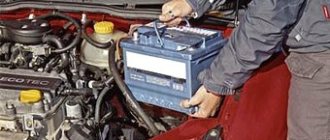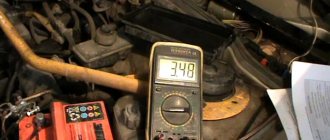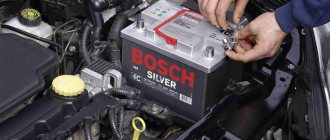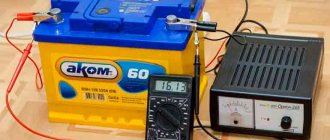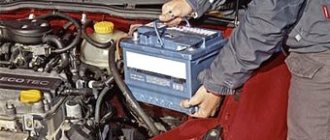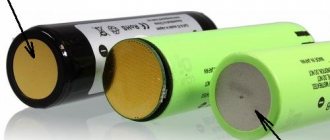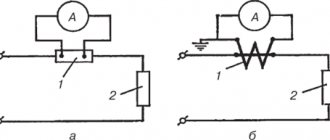General points
The electromotive force is responsible for the normal flow of current through the circuit and gives a programmed difference in the output parts of the power source - that is, the battery. The required value will be calculated as the potential difference.
The electromotive force is equal to the energy spent on charge transfer between the terminals. The values of current forces and voltages are inextricably linked with each other. When this force does not occur inside the battery, there is no current at the output parts.
When the circuit connections are opened, there is no current, but an electromotive force begins to be excited in the battery, and movement appears in the terminal area.
Volts are used to measure both quantities. The total electromotive force in a car battery develops as a result of electrical and chemical processes occurring inside it. The EMF is always greater than the voltage in the battery by an amount equal to the drop in the internal voltage.
Voltmeters and multimeters are used for measurements. In a car battery, the dimensions of the EMF will depend on the density and temperature values of the electrolyte.
There is no exact information on what is the ideal value for a battery. Experts take into account the optimal starting parameters for starting the motor mechanism. If the battery is new and charged, this value should be 12.6–12.7 volts.
If the voltage of a charged car battery without a load is higher, this does not indicate a problem.
For example, immediately after charging the battery, its current during measurements will be 0.5 volts higher than the real one, and this must be taken into account in the final calculations. 13.0–13.2 volts is a figure that exceeds the permissible voltage values, but for some battery models it is normal.
The battery shows data close to the recommended values a couple of hours after charging.
12 volts or less is considered critical for the battery. If the value is less than this figure, urgent charging is needed. It is impossible to use the battery at its resource limit, since in this case the process of sulfation of the plates will start. In the future, it will be problematic to get rid of the effects of sulfation, and you will have to buy a new battery.
At the same time, 12.1 volts is enough to start the engine; problems arise at 11.6 volts and below. These are all numbers that you need to know about and take into account while working. In most cases, the voltage of a charged car battery is around 12.2–12.5 volts.
Charge table
In order not to miss the moment when the battery charge drops to an extremely critical level, use the battery charge table. If you measure U at the terminals, you can calculate the total charge.
Also in the table you will find the values of electrolyte density and temperature values at which it can freeze in winter. You can familiarize yourself with the main values in the table of car battery charge by voltage.
Why is the battery being recharged?
Overcharging the battery from the charger is a consequence of incorrect selection of charging time, voltage and current in manual mode or a malfunction of the charging unit itself. A short-term recharge from a charger is less dangerous than from a generator, since it usually does not have time to lead to irreversible consequences.
The reasons for overcharging the car battery on board are 90% due to a faulty generator. Therefore, it is this that needs to be inspected and checked first. Less commonly, the cause of battery overcharging lies in wiring faults. Specific causes of increased voltage and their consequences are listed in the table.
Table of reasons for overcharging a car battery:
| Causes | What causes overcharging? |
| Generator relay problems | The relay is not working correctly, the voltage in the on-board network is too high or voltage surges are observed. |
| Faulty generator | The generator, due to a short circuit in the windings, a breakdown in the diode bridge or for other reasons, cannot maintain the operating voltage. |
| Regulator relay failure | The voltage regulator relay (“tablet”, “chocolate bar”) does not function, which is why the output voltage significantly exceeds the permissible value. |
| Weak contact of the relay-regulator terminal | Due to the lack of contact, the relay receives an undervoltage, as a result of which a compensating effect is not generated. |
| Consequences of generator tuning | To increase the voltage on older models (for example, VAZ 2108-099), craftsmen install a diode between the terminal and the relay regulator, which lowers the voltage by 0.5–1 V in order to deceive the regulator. If the diode was initially selected incorrectly or the drop increased due to its degradation, the voltage in the network increases beyond the permissible limit. |
| Weak contact in wiring | When the contacts on the connecting blocks oxidize and move away, the voltage on them drops, the regulator regards this as a drawdown and increases the output voltage. |
In some vehicles, battery overcharging from the alternator is a common problem caused by design flaws. The table below will help you find out which models are overcharging the battery and what is the reason for it.
Generators of modern cars, designed to use calcium batteries (Ca/Ca), produce higher voltages than on older models. Therefore, the voltage of the on-board network is 14.7–15 V (and for a short time in winter - even more) is not a sign of overcharging!
A table with the causes of “congenital defects” in some cars, which lead to overcharging of the battery:
| car model | Reason for recharging the battery from the generator |
| UAZ | Overcharging often occurs due to poor contact of the regulator relay. It often occurs on “loaves”, but it also happens on Patriots. At the same time, the original voltmeter is not yet an indicator of overcharge, since it can go off scale for no reason. You need to check the recharge only with a known accurate device! |
| VAZ 2103/06/7 (classic) | Poor contact in the contact group of the lock (terminals 30/1 and 15), on the contacts of the relay-regulator, and also due to poor ground contact between the regulator and the car body. Therefore, before replacing the “chocolate”, you need to clean all these contacts. |
| Hyundai and Kia | On Hyundai Accent, Elantra and other models, as well as on some KIAs, the voltage regulator unit on the generator (catalog number 37370-22650) often fails. |
| Gazelle, Sable, Volga | Poor contact in the ignition switch and/or fuse box connector. |
| Lada Priora | Voltage drop at generator contact L or 61. If it is lower by more than 0.5 V than at the battery, you need to check the wiring and look for the place of the drawdown. |
| Ford Focus (1,2,3) | Voltage drop at the generator regulator connector (red wire). Often the regulator itself fails. |
| Mitsubishi Lancer (9, 10) | Oxidation or breakage in the generator chip of contact S (usually orange, sometimes blue), due to which the RR produces increased voltage. |
| Chevrolet Cruze | A mains voltage slightly higher than 15 V is normal! The ECU analyzes the condition of the battery and, using PWM, regulates the voltage supplied to it in the range of 11–16 V. |
| Daewoo Lanos and Nexia | On Daewoo Lanos (with GM engines), Nexia and other GM cars with “related” engines, the reason for overcharging almost always lies in a malfunction of the regulator. The problem of replacing it is complicated by the difficulty of dismantling the generator for repairs. |
All verification methods
There are different ways to check the voltage of a car battery for its level of discharge. Let's look at them.
Multimeter
To check Akum, Vatra and other brands of batteries installed on KamAZ, Volvo, and BMW vehicles, it is convenient to use a multimeter.
You will find the device in any specialized store; it is available at service stations. For one-time measurements, it’s easier to borrow a multimeter, although most drivers need it regularly.
Most likely, the readings of the multimeter and the on-board computer will differ.
Standard dashboard devices often make mistakes and give an insignificant error, since they are not directly connected to the battery. Usually the deviations are on the smaller side.
With the engine running
We have figured out what voltage should be on a charged car battery, now we will consider the procedure for measuring current indicators with the engine running.
First, take measurements with the engine running - normally the value should be around 13.5–14.0 volts.
If the value is greater than 14.2 volts, the charge is low, the generator will direct energy to charge the battery. Excessive indicators in the winter season are considered the norm in this case.
There is nothing wrong with high current. When everything is in order with the electrical equipment, after 10 minutes the electronic parts of the system will drop the current values to the standard maximum 14 volts.
In the absence of this reaction, the figure is not gradually reset to optimal values, and the battery may be overcharged. It will constantly function at maximum efficiency and the electrolyte will begin to boil away.
When the indicator is less than 13.0–13.4 volts when the engine is turned on, we can talk about the lack of full charge. Do not immediately run to the service center; first, measure the readings with the consumers turned off - this is the air conditioner, radio, headlights, cigarette lighter, etc.
A sharp drop is also possible if the contacts are oxidized - check them before going to the service center and, if necessary, clean them with sandpaper.
Another method of checking is with the power consumption sources turned off and the engine running, you should get 13.6. Check the parameters for compliance, if everything is normal, turn on the low beam, and the indicator should drop by 0.1–0.2 volts.
Now turn on music, split-system, and other energy consumers in the car. Perform the actions gradually, each time you turn on the consumer again, the parameter should drop slightly.
If there are sudden surges, most likely the problem is in the generator system - it is not working at full power, or the brushes are worn out or dirty.
Even if all energy consumers are turned on, the indicator still does not normally fall below 13 V. Otherwise, the battery will begin to discharge heavily and will run out completely.
With the motor off
You will also need a multimeter to carry out the work. If the reading on the terminals is below 11.8 volts, the car most likely simply will not start; you will have to light it from another car.
The normal level with the engine turned off is 12.5–13.0 volts. A value of 12.9 indicates that the battery is approximately 90% charged, 12.5 - half charged, 12.1 - no more than 10% remaining. These are calculations by eye, but many motorists use them.
What causes battery overcharging?
When a problem is identified, it is important to urgently eliminate overcharging of the car battery, the consequences of which may not be limited to battery failure. Due to the increased voltage, other components may also fail. What does overcharging of the battery lead to and for what reasons - see the table below:
What are the dangers of overcharging the battery: main malfunctions
| Consequences of overcharging | Why is this happening | How can this end? |
| Electrolyte boiling away | If current continues to flow to a 100% charged battery, this causes active boiling of the electrolyte and the formation of oxygen and hydrogen in the banks. | A decrease in the electrolyte level leads to overheating and destruction of the plates. A small explosion and fire are possible due to the ignition of hydrogen (due to a spark discharge between the exposed plates). |
| Shedding of plates | Under the influence of current, the plates, which were exposed after the liquid boiled away, overheat, their coating cracks and crumbles. | The battery cannot be restored; you will have to buy a new battery. |
| Electrolyte leakage | As the electrolyte boils away, it is released through the ventilation holes and enters the battery housing. | The acid contained in the electrolyte corrodes the paintwork in the engine compartment, some types of wire insulation, pipes and other parts that are not resistant to aggressive environments. |
| Battery swelling | When the electrolyte boils, the pressure rises and the batteries (especially maintenance-free ones) swell. Lead plates crumble or short out due to deformation. | If excessive pressure is applied, the battery housing may burst, damaging and spattering acid into parts under the hood. |
| Terminal oxidation | As the acid electrolyte evaporates from the battery, it condenses on adjacent parts, causing the battery terminals and other components to become covered with a layer of oxides. | Deteriorated contact leads to disruption of the electrical network on board; acid can corrode the insulation and pipes. |
| Electronics failure | Overvoltage causes damage to power-sensitive electronic components and sensors. | Due to excess voltage, lamps and fuses burn. In modern models, failure of the ECU, air conditioning unit and other on-board electronics modules is possible. There is an increased risk of fire due to overheating and destruction of insulation, especially when using non-standard low-quality accessories and spare parts. |
| Generator burnout | Failure of the relay regulator and short circuit of the windings cause overheating of the generator. | If overheating of the generator leads to burnout of its windings, you will have to rewind the stator/rotor (which is time-consuming and expensive) or replace the generator assembly. |
Regardless of the type of battery, it is important to prevent it from overcharging. For all types of batteries, overcharging the battery is equally dangerous, but the consequences may be different:
A battery explosion is a consequence of overcharging.
- Antimony (Sb-Sb) . Classic serviceable batteries, in which the plates are doped with antimony, survive a short overcharge relatively easily. With timely maintenance, everything will be limited to adding distilled water. But it is these batteries that are more sensitive to high voltage, since recharging is possible already at a voltage of more than 14.5 volts.
- Hybrid (Ca-Sb, Ca+) . Maintenance-free or low-maintenance batteries, the positive electrodes of which are doped with antimony, and the negative electrodes are doped with calcium. They are less afraid of overcharging, withstand voltages better (up to 15 volts), and slowly lose water from the electrolyte when boiling. But, if you allow a strong overcharge, then such batteries swell, a short circuit is possible, and sometimes the case ruptures.
- Calcium (Ca-Ca) . Maintenance-free or low-maintenance batteries of the most modern subtype. They are characterized by minimal water loss during boiling, are resistant to high voltage (at the last stage they are charged with a voltage of up to 16–16.5 volts), therefore they are minimally susceptible to overcharging. If you allow it, the battery may also burst, splashing everything with electrolyte. Strong overcharge and deep discharge are equally destructive, as they cause irreversible degradation of the plates and their shedding.
- With absorbed electrolyte (AGM) . AGM batteries differ from classic ones in that the space between the electrodes is filled with a special porous material that absorbs electrolyte. This design prevents natural degradation, allowing it to withstand many charge-discharge cycles, but it is very susceptible to overcharging. The maximum charging voltage is up to 14.7–15.2 V (indicated on the battery), if more is applied, there is a high risk of electrodes shedding. And since the battery is maintenance-free and sealed, it can explode.
- Gel (GEL) . Batteries in which the liquid acid electrolyte is thickened with silicon compounds. These batteries are practically not used as starter batteries, but can be installed to power powerful consumers on board (music, etc.). They tolerate discharge better (withstand hundreds of cycles), but are afraid of overcharging. The maximum voltage for GEL batteries is up to 14.5–15 V (sometimes up to 13.8–14.1). Such a battery is sealed, so it is easily deformed and cracked when overcharged, but in this case there is no danger of electrolyte leakage.
Useful tips
Recommendations that will be useful during operation and maintenance of the battery to extend its operating time:
- test the battery from time to time and recharge it from the mains as often as possible (at least once a quarter);
- Make sure that the generator, wires, and car voltage regulation functions are in good condition to ensure the battery is properly charged while traveling;
- measure current leakage;
- measure the density of the electrolyte substance after full charging, compare the numbers from the table above, correct the situation if necessary;
- Keep your car battery clean to minimize leakage current.
Do not short-circuit the output terminals of a car battery, as the consequences in this case will be disastrous.
Features of the circuit or why the generator voltage may jump
The above is a general diagram of the circuit, without details, but it is enough to understand how everything works. Now about the features of battery recharging.
The generator cannot independently regulate the parameters of the generated electricity, so the output voltage from it varies (jumps), and in a significant range; it depends on the crankshaft speed and the load in the on-board circuit.
That is, the battery is essentially constantly being recharged while the generator is generating electricity.
In order for the battery to accept a charge, you need to apply a voltage to it slightly higher than the nominal value of the battery itself. The input voltage on the battery differs on different cars, but in general, this figure is in the range of 13.9-14.5 V.
It is at this voltage that the battery can “take” a charge. If the voltage is lower, the battery will be undercharged, and if the voltage is higher, it will be overcharged. Both situations have a negative impact on the battery.
The generator produces a voltage with a high value, and in order to maintain it in the circuit within the required limits, a relay regulator is included in the circuit.
On some models, this element is included in the design of the generator and is combined with a brush assembly (the most common design) or is a separate unit (found, for example, on the VAZ of the classic family).
In fact, the relay-regulator is the only element responsible for ensuring that the voltage in the on-board network corresponds to the norm and that overcharging does not occur, taking into account the load created in the on-board network when electrical consumers are turned on.
Useful tips for car enthusiasts
To charge a battery, you do not need any professional knowledge, since this process does not present any particular difficulties. To do this, you just need to carefully read the operating instructions for the charger, have information about the battery, and also understand what current is preferable for charging the battery. The service life of the battery depends on this.
Correct connection of the charger
What happens if you charge with less current?
A small charge proportionally increases the recovery time of the battery capacity. In some cases, it is not possible to charge with the required current. Most non-professional chargers are designed with a maximum rating of 5 Amps. A battery with a capacity of 100 Amp-hours will take 20 hours to charge, that is, a day.
The good news is that small amounts of charge do not harm the battery. On the contrary, there is an ancient method of battery restoration. First, it is charged for a long, long time with a small value of 1 Ampere, then quickly discharged with extra current.
Correct connection of the charger
To avoid loss of information by the engine control unit, failure of additional equipment settings and other troubles caused by removing the battery and disconnecting all systems from power, it is recommended to charge the battery directly on the car. To do this you need to follow some rules:
- All electrical appliances during preparation and direct charging should be turned off or put into sleep mode;
- It is recommended to connect the charger to the battery terminals only when it is turned off and at a minimum current;
- in the process of charging the car battery, the battery charging current must be gradually added;
- - the contact on the terminals must be of the highest quality.
If the current drops during charging, this means that the charger circuit is tied to voltage. When charging the battery, the charge level rises, and the current also increases accordingly.
There are several charging methods and each of them has its own characteristics.
Battery charging circuit
For a general understanding of the reasons for overcharging, first consider the battery charging circuit diagram. And although it is structurally different on different cars, the general principle of construction is the same.
This circuit includes:
- Generator.
- Rectifier block (diode bridge).
- Relay regulator.
- Fuse box.
- Egnition lock.
- Charge indicator lamp.
- Battery
The charging system works using the example of the VAZ 2106 and other cars from the “VAZ classic” series as follows:
- After starting the power plant, through a belt drive, the crankshaft begins to rotate the generator rotor, as a result of which this unit generates electricity.
- Since automobile generators use alternating current, the generated energy goes to the rectifier unit, where alternating current is converted into direct current.
- After the rectifier unit, the electricity is supplied to the relay regulator, whose task is to maintain the voltage in a given range.
- After the regulator, the electrical energy passes through the circuit through the fuse box, the ignition switch and the charge indicator lamp, then returns to the output of the generator, and from there it is supplied to the battery.
The detailed diagram is shown below.
Constant current charging
With this method, the current strength acts as a constant, and the average battery charging current can be calculated as follows:
- for acid batteries - divide the battery capacity according to the passport by 10;
- for alkaline – divide by 4.
Acid batteries for cars are more sensitive to operating conditions and modes during the charging process, and such batteries are the most common type. The battery charging current in a car is selected in the ratio of its total capacity produced by 0.1. Those. if this capacity is 60A/h, then the current is set to 6A.
To charge a motorcycle battery with a capacity of 6A/h, a current of 0.6 Ampere is sufficient. Such a current can be provided by a portable pulse charger “Aida UP-12”.
When charging a battery with direct current, you need to monitor the temperature and density of the electrolyte, as well as the voltage on the battery.
With this method, you need to control the temperature of the electrolyte, its density and battery voltage. The fact that the battery is fully charged is indicated by the constant voltage and density of the electrolyte, as well as the rapid release of gases. But the process requires periodic monitoring (at least every hour), since for high-quality charging, the current must be regulated and not allow gas release during the charging period.
To increase the battery charge level, the current must be halved when the voltage is increased to 14.4V. Charging the battery with low current continues until gas emissions begin.
What to do when recharging?
When recharging a battery, you should first find the root cause, and then diagnose the battery. What you need to do when recharging a battery for specific reasons is described below.
Recharging with a stationary charger
Overcharging the battery from the charger is possible when using a faulty power supply or incorrectly selected charging parameters in manual mode.
- Maintenance-free batteries are charged with a constant current of 10% of their capacity. The voltage will be adjusted automatically, and when it reaches 14.4 V, the current must be reduced to 5%. Charging should be interrupted no more than 10–20 minutes after the electrolyte begins to boil.
- Serviced . Use constant charging voltage recommended for your battery (slightly higher for calcium batteries than for hybrid or AGM batteries). When the capacity reaches about 100%, the current will stop flowing and charging will stop on its own. The process can take up to a day.
Before charging a serviced battery, check the density of the electrolyte with a hydrometer. If it does not correspond to normal for a given state of charge, then even when charging with standard voltage and current, overcharging is possible.
Overcharging of a car battery by a charger usually occurs due to a malfunction of certain components. In transformer chargers, the cause of an increase in voltage is often an interturn short circuit of the winding, a breakage of the switch and a malfunction of the diode bridge. In automatic pulse memory devices, the radio components of the control controller, for example, transistors or an optocoupler regulator, often fail.
Protection of a car battery from overcharging is guaranteed when using a charger assembled according to the following scheme:
Protecting the battery from overcharging: do-it-yourself circuit
12 volt battery overcharge protection: charger circuit
Recharging a car battery from a generator
If overcharging of the battery is detected while traveling, you need to protect the battery from boiling over or exploding by reducing the supply voltage or turning off its supply in one of three ways:
- Loosening the tension of the generator belt . The belt will slip, whistle and most likely become unusable and require replacement in the near future, but the power of the generator will drop.
- Turn off the generator . By removing the wires from the generator and insulating the hanging terminals, you can get home on the battery, using minimal electrical appliances on board. A charged battery will last for about 1–2 hours of driving without headlights on, with headlights on – half that time.
- Remove the belt from the generator . This advice applies to models in which the alternator is driven by a separate belt. The effect is identical to the previous option, but the method may be simpler if you unscrew the two tension screws to remove the belt. This is more convenient than removing terminals and insulating wires.
If the generator voltage does not exceed 15 volts, and you are traveling close, there is no need to turn off the generator. Just drive at low speed to the repair site, turning on as many consumers as possible: low beam, heater fan, glass heating, etc. If additional consumers allow you to reduce the voltage, leave them on.
Sometimes turning on additional consumers helps to find the cause of overcharging. If the voltage drops as the load increases, the problem is probably in the regulator, which simply increases the voltage. If, on the contrary, it grows, you need to look at the wiring for poor contact (twists, oxides of connectors, terminals, etc.).
The battery is overcharged from the generator when the regulating elements (diode bridge, regulator relay) do not operate correctly. The general check procedure is as follows:
- The voltage at the battery terminals at idle speed should be 13.5–14.3 V (depending on the car model), and when it increases to 2000 or more, it increases to 14.5–15 V. If it rises noticeably more, recharging occurs.
- The difference between the voltage at the battery terminals and at the output of the relay regulator should not exceed 0.5 V in favor of the battery. A big difference is a sign of poor contact.
- We check the relay regulator using a 12-volt lamp. You need an adjustable voltage source with a range of 12–15 V (for example, a charger for a battery). Its “+” and “-” must be connected to the PP input and ground, and the lamp to the brushes or PP output. When the voltage increases above 15 V, the lamp that lights up when power is applied should go out. If the lamp continues to light, the regulator is faulty and must be replaced.
Relay-regulator test circuit
Checking the regulator relay: video
If the relay-regulator works, you need to check the wiring. When the voltage drops in one of the circuits, the generator gives full load and the battery is recharged.
To prevent overcharging of the battery, monitor the condition of the wiring and periodically check the voltage at the terminals. Do not keep wires twisted, solder connections and use heat shrink tubing instead of electrical tape to protect connections from moisture!
In some cars, in which charging goes from the B+ terminal of the generator directly to the battery, you can, to be on the safe side, organize protection of the battery from overcharging through a voltage control relay like 362.3787-04 with a regulation range of 10–16 V. Such protection from overcharging a 12 volt battery will stop the power supply on it when the voltage rises above what is permissible for this type of battery.
Installation of additional protection is justified only on older models, which are especially susceptible to battery overcharging due to design flaws. In other cases, the regulator independently copes with charging control.
A relay is connected to the gap in wire P (marked with red stripes).
Generator connection diagram:
- Accumulator battery.
- Generator.
- Mounting block.
- Battery charge indicator lamp.
- Ignition switch.
Before installing the relay on the charging wire from the generator to the battery, study the wiring diagram of your car model. Make sure that if the wire is broken using a relay, the current will not bypass the battery!
Fast charging
This method is used to accelerate the restoration of the battery’s operating condition by charging at increased current values. It differs from the method described above only in that in this case the current used to charge the battery is slightly greater. Its value is set depending on the maximum possible current that the charger is capable of delivering.
Accelerated charging of the battery, with constant use, shortens its service life
The main disadvantage of the accelerated charging method (if repeated frequently) is the reduction in battery life. Therefore, it is not advisable to use this method. Since forced charging does not involve charging the battery until its capacity is completely restored, it must be recharged in the near future using a more acceptable method.
How and what is the best way to charge the battery
By the way, safety requirements when charging a battery should always come first. Since this procedure is an electrochemical process accompanied by the release of gases, according to the rules, it must be carried out in a well-ventilated, fire-proof room. And always at positive temperatures (preferably in the range of 20–25 degrees). Only in this case will optimal conditions be provided for high-quality battery charging and effective replenishment of its capacity.
Charging the battery at a stable voltage
The charge level, when using this method, depends directly on the voltage that the charger is able to provide. For example, if the highest voltage at the output of the charger is 14.4V, then with continuous charging throughout the day, the battery will be charged to a maximum of 85%, at this voltage value of 15V - up to 90%, at 16V - up to 97%. Full charging can only be achieved when using a charger with an output voltage of 16.4 V.
Fully charging the battery at constant voltage requires at least 24 hours
This method allows you to charge the battery automatically; there is no need to monitor the process. The end of charging is determined by the voltage at the battery terminals; it should be equal to the voltage at the charger output plus 0.1V. But for 95% charge, if charging is done using a charger with an output voltage of 14.4V, it will take more than 24 hours.
Most frequently asked questions
Will the battery be recharged if a higher power generator is installed?
No, because regardless of the power of the generator, the voltage at its output is limited by the relay regulator to the maximum permissible for the battery.
Does the diameter of the power wires affect recharge?
The increased diameter of the power wires in itself cannot cause the battery to overcharge. However, replacing damaged or poorly connected wiring may increase the charging voltage if the alternator is faulty.
How to properly connect the second (gel) battery so that there is no overcharging?
To prevent overcharging of the gel battery, it must be connected through an isolation device. To prevent overvoltage, it is advisable to use a limiter terminal or another voltage controller (for example, voltage control relay 362.3787-04).
The generator recharges the battery, is it possible to drive home with the battery removed?
If the relay regulator is broken, you cannot disconnect the battery at all. Reducing the load will raise the already high voltage from the generator, which can cause lamps and on-board electronics to fail. Therefore, when recharging the car instead of the battery, turn off the generator.
Do I need to change the electrolyte after recharging the battery for a long time?
The electrolyte in the battery is changed only after the battery has been refurbished. Replacing the electrolyte that has become cloudy due to crumbling plates by itself does not solve the problem. If the electrolyte is clean, but its level is low, you need to add distilled water.
How long can a battery be charged to increase the density of the electrolyte (evaporate water)?
Time limits are individual and depend on the initial density. The main thing is not to exceed the charge current of 1–2 A and wait until the electrolyte density reaches 1.25–1.28 g/cm³.
Charging the battery with pulse current
Pulse charging is the use of a charger with a variable current or voltage, i.e. their values increase and decrease at certain intervals. Pulse current is divided into asymmetric and pulsating.
When charging at an asymmetric current, its polarity changes in each cycle. But the electric charge is greater with direct polarity than with reverse polarity (the ratio of charge to discharge is 10/1, and the duration of their pulses is 1/2). Thanks to this, the battery is charged.
The pulsating current charges the battery by changing its magnitude, while the polarity remains unchanged.
Charging the battery using a current stabilizer
The current stabilizer for charging the battery is a device with a transformerless circuit with capacitors. This device allows you to charge up to 4 batteries simultaneously with a stable current of 130mA. The current can be reduced to 65mA by removing 1 capacitor.
When using a voltage stabilizer, you can simultaneously charge up to 4 batteries
The batteries must be connected in parallel to the placement of the zener diodes in the circuit, while maintaining polarity. It is the zener diodes that allow you to simultaneously charge 4 batteries without a switch, due to the fact that during charging it is in the closed position, and when the battery is not in the cell, the zener diode opens, which facilitates the passage of current.
The batteries are connected to the current stabilizer immediately before it is connected to the network. When using it, you should be extremely careful, because its output terminals are connected to the network, and one careless movement can lead to electric shock.
Why is it important to set the charge current correctly?
The battery charging current is a defining characteristic of the charging mode. In the generalized case, it is the concept of charge “mode” that should be considered. Several types of batteries are used in cars with internal combustion engines:
- Acidic (antimony, calcium, etc.);
- AGM batteries;
- Gel.
Each of these types requires its own charging mode. For example, an AGM battery is fully charged in three stages:
- Main charge.
- Recharge.
- Final charge and preservation.
A conventional battery is charged in a single-stage mode. Deviation of values from standard values can lead to:
- reducing the effectiveness of the operation;
- loss of consumer characteristics;
- destruction of the battery.
